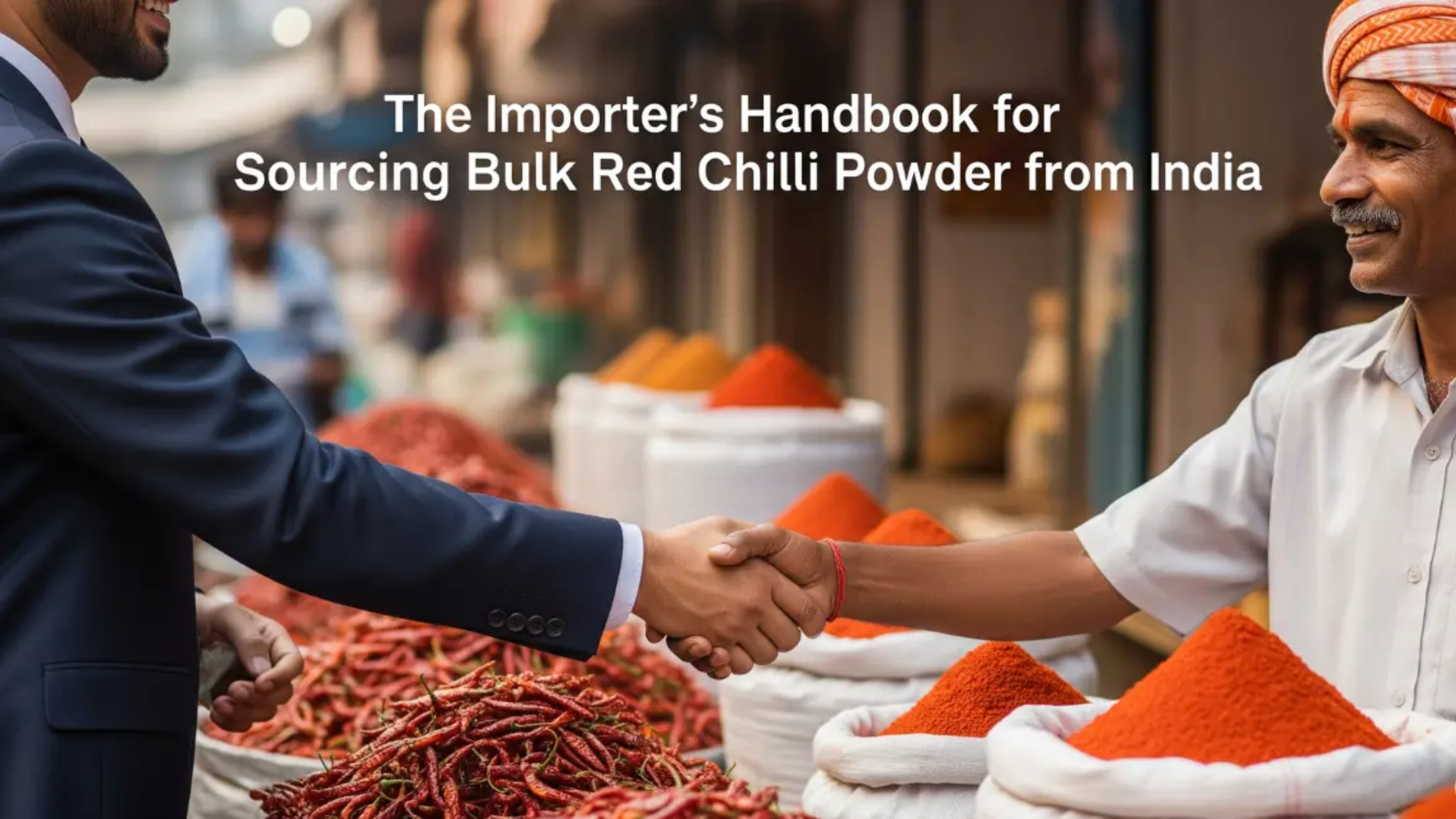The global appetite for authentic, fiery Indian Spices is insatiable, and at the heart of this demand is the vibrant and pungent red chilli powder Indian varieties are famous for. For international importers and food manufacturers, sourcing this essential spice directly from India offers immense opportunities for quality and value. However, the process can be complex, filled with nuances in quality, purity, and logistics.
Navigating the market requires more than just a purchase order; it requires knowledge. This handbook is your definitive guide to sourcing bulk red chilli powder from India, ensuring every shipment meets your standards for quality, safety, and flavour, and helping you build a successful partnership with trusted red chilli powder exporter.
Understanding the Landscape of Indian Red Chilli Powder
India is the world’s largest producer, consumer, and exporter of chillies, boasting a dazzling array of varieties. Before you import, it’s crucial to understand the main types to match them to your market’s needs:
Guntur Varieties (Sannam & Teja): Hailing from Andhra Pradesh, these are the workhorses of the chilli world. Guntur Sannam is known for its medium pungency, while Teja is one of the hottest varieties, prized for its intense heat. They are a top choice for those seeking a powerful kick.
Kashmiri Chilli: Famous for its vibrant, deep red colour and extremely mild heat. This variety is used primarily as a natural food colourant in countless dishes. If your product’s visual appeal is paramount, Kashmiri is the answer.
Byadgi Chilli: Originating from Karnataka, the Byadgi chilli is known for its deep red hue and moderate heat level. It offers a great balance of colour and pungency, making it a popular all-rounder.
The Importer's Checklist: Key Quality Parameters
A professional buyer looks beyond the basic product. Your focus should be on these four critical quality parameters when evaluating red chilli powder from india.
Heat Level (Scoville Heat Units – SHU): The SHU scale measures the pungency or “hotness” of chilli powder. This is a non-negotiable specification. A mild powder might be 1,000-2,000 SHU, while a fiery Teja chilli can be 50,000-100,000 SHU. Ensure the SHU level aligns with your product formulation and consumer preference.
Colour Value (ASTA): The American Spice Trade Association (ASTA) color value measures the extractable colour of the chilli. A higher ASTA value (e.g., 120-160 ASTA for Kashmiri) indicates a more vibrant and stable red colour, which is a key quality marker for sauces, seasonings, and snacks.
Purity and Adulteration: This is a major concern in the spice trade. Reputable exporters will provide lab reports guaranteeing their powder lal mirch is free from common adulterants like brick powder, sawdust, or illegal artificial colourants like Sudan dyes.
Moisture Content: The moisture level should ideally be below 10-11%. Higher moisture can lead to microbial growth, mould, and caking, drastically reducing the product’s shelf life and usability.
Spice Up Your Business with Authentic Indian Flavors
Import and Export Excellence from India!

How to Vet and Select Red Chilli Powder Exporters
Your supplier is your partner in quality. Use this three-step process to vet potential exporters:
Step 1: Verify Certifications: A professional exporter should readily provide internationally recognized food safety certifications like ISO 22000, HACCP, or FSSC 22000. They should also be registered with the Spices Board of India.
Step 2: Demand a Certificate of Analysis (COA): For every batch, request a COA from an accredited third-party laboratory. This document is your proof of quality. It should verify the SHU, ASTA value, moisture content, and confirm that the powder is free from contaminants like aflatoxins and heavy metals.
Step 3: Request and Evaluate Samples: Never place a bulk order without testing a sample. Evaluate it against the promised specifications. Check its colour, aroma, texture, and taste. Does it meet your expectations? A small discrepancy in a sample can become a major problem in a multi-tonne shipment.
Navigating Logistics: From India to Your Port
Sourcing is only half the battle; getting the product to your facility in perfect condition is the other half.
Packaging: bulk red chilli powder must be protected from moisture and light. The industry standard is multi-layer paper bags, jute bags, or HDPE bags with an inner food-grade poly-liner to maintain freshness and prevent contamination.
Documentation: A smooth customs clearance process depends on accurate documentation. Ensure your supplier can provide an error-free Commercial Invoice, Packing List, Bill of Lading/Airway Bill, and Certificate of Origin.
Shipping Terms (Incoterms): Clarify the shipping terms from the outset (e.g., FOB, CIF, EXW). This defines who is responsible for the shipment at each stage and avoids hidden costs.
Sourcing red chilli powder Indian varieties offer is a strategic decision that can elevate your products. By following this handbook, you can navigate the process with confidence, ensuring you procure a high-quality, safe, and authentic product that will delight your customers.
Frequently Asked Questions (FAQs)
1. What is a good ASTA value for red chilli powder?
A good ASTA value depends on the application. For products where colour is critical, like paprika or Tandoori spice blends, a value of 100 or higher is desirable. For general seasoning, a value of 60-80 might be sufficient.
2. How can I be sure the chilli powder is free from illegal dyes like Sudan?
Insist on a Certificate of Analysis (COA) from a reputable, accredited laboratory that specifically tests for and confirms the absence of artificial colourants, including Sudan I, II, III, and IV.
3. What is the difference between “stemless” and “with-stem” chilli powder?
Stemless chilli powder is made from chillies where the stems have been removed before grinding. This results in a higher quality, purer powder with better flavour and colour. “With-stem” powder is cheaper but can have a higher fibre content and slightly duller taste.
4. What are the typical payment terms for bulk orders from India?
Common terms include an advance payment (often 30-50%) with the balance paid against a copy of the shipping documents (Bill of Lading), or through an irrevocable Letter of Credit (LC) for larger orders.
5. Which Indian chilli variety is best for making hot sauce?
The Guntur Teja chilli is a favourite for hot sauces due to its very high heat level (high SHU) and robust flavour. It provides the fiery kick that hot sauce enthusiasts look for.
6. Does the grinding method affect the quality of chilli powder?
Yes. Cryogenic grinding, which uses liquid nitrogen to freeze the chillies before grinding, is a superior method. It preserves the colour, flavour, and volatile oils (which determine aroma and taste) much better than traditional grinding methods that generate heat.
7. Is lal mirch powder the same as red chilli powder?
Yes, lal mirch powder is the Hindi term for red chilli powder. They refer to the same product.
8. What is the Spices Board of India, and why is it important?
The Spices Board of India is the government body responsible for promoting and regulating the export of Indian spices. A supplier registered with the Spices Board is generally considered more credible and compliant with quality standards.



Leave A Comment